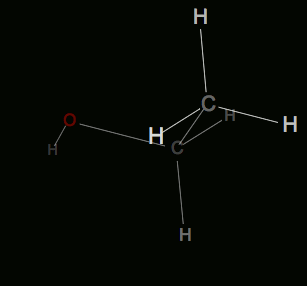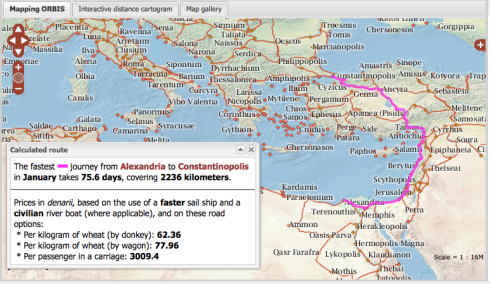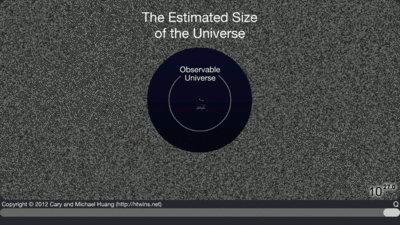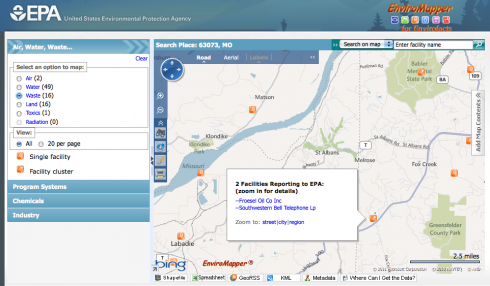Based on Euler’s Method, this interactive graph illustrates a numerical method for solving differential equations. This approach is at the core of many sophisticated computer models of physical phenomena (like climate and weather).
[inline]
If you know the equation for the slope of a curve (the red line for example),
and a point that the curve passes through, such as , you can integrate to find the equation of the curve:
[script type=”text/javascript”]
var width=500;
var height=500;
var xrange=10;
var yrange=10;
mx = width/(2.0*xrange);
bx = width/2.0;
my = -height/(2.0*yrange);
by = height/2.0;
function upause () {
ct = 1;
}
function draw_9110(ctx, polys) {
t_9110=t_9110+dt_9110;
//ctx.fillText (“t=”+t, xp(5), yp(5));
ctx.clearRect(0,0,width,height);
polys[0].drawAxes(ctx);
polys[0].slopeField(ctx, 1.0, 1.0, 0.5);
ctx.lineWidth=2;
polys[0].draw(ctx);
polys[0].write_eqn(ctx, “slope = dy/dx”);
eu = eu_9110;
//override nsteps values
//max_nsteps_9110 = eu.nsteps;
//eu.nsteps = nsteps_9110;
if (nsteps_9110 <= max_nsteps_9110) { nsteps_9110 = nsteps_9110 + 1;}
else { nsteps_9110 = 0; }
eu.nsteps = nsteps_9110;
if (show_parabola_9110 == 1) {
polys[0].Integrate(ctx, eu.x1, eu.y1);
polys[0].integral.color = '#3c3';
polys[0].integral.draw(ctx);
}
pos = polys[0].EulerApprox(ctx, eu);
//document.getElementById('comment_9110').innerHTML = eu.nsteps+ " " + eu.x1 + " " + eu.y1+ " " + eu.dx+ " " + eu.dir+ " " + max_nsteps_9110;
//starting point label
ctx.textAlign="right";
ctx.textBaseline="alphabetic";
ctx.font = "14pt Calibri";
ctx.fillStyle = "#00f";
ctx.fillText ('start = ('+eu.x1+','+eu.y1+")", xp(eu.x1-0.25), yp(eu.y1-0.5));
//pos = polys[0].EulerApprox(ctx, st_pt_x_9110, st_pt_y_9110, 0.5,20,-1);
//pos = polys[0].EulerApprox(ctx, st_pt_x_9110, st_pt_y_9110, 1, 6,1);
//draw starting point
ctx.strokeStyle="#00f";
ctx.lineWidth=2;
ctx.beginPath();
ctx.arc(xp(eu.x1),yp(eu.y1),dxp(0.1),0,Math.PI*2);
ctx.closePath();
ctx.stroke();
//ctx.fillText (' c='+move_dir_9110+' '+polys[1].c, xp(5), yp(5));
}
//init_mouse();
var c_9110=document.getElementById("myCanvas_9110");
var ctx_9110=c_9110.getContext("2d");
var change = 0.0001;
function create_lines_9110 () {
//draw line
var polys = [];
polys.push(addPoly(0, 0.5, -1));
return polys;
}
function set_max_nsteps_9110 (eu) {
max_nsteps_9110 = 1.5*(xrange - eu.x1)/eu.dx;
}
var polys_9110 = create_lines_9110();
var x1=xp(-10);
var y1=yp(1);
var x2=xp(10);
var y2=yp(1);
var dc_9110=0.05;
var t_9110 = 0;
var dt_9110 = 500;
var st_dx_9110 = 1.0;
var st_nsteps_9110 = 0;
var nsteps_9110 = 0;
var max_nsteps_9110 = 20;
var dir_9110 = 1;
var show_parabola_9110 = 1;
var st_pt_x_9110 = -2;
var st_pt_y_9110 = -3;
var move_dir_9110 = 1.0; // 1 for up
//Form interaction
function update_form_9110 (x, y, dx, nsteps, dir, b, c, show_para) {
x_9110.value = st_pt_x_9110+"";
y_9110.value = st_pt_y_9110+"";
dx_9110.value = st_dx_9110.toPrecision(2);
//c_max_nsteps_9110.value = max_nsteps_9110+"";
//document.getElementById('comment_9110').innerHTML = c_dir_9110;
if (dir == 1) { c_dir_9110.selectedIndex = 0; }
else {c_dir_9110.selectedIndex = 1;}
b_9110.value = b+"";
c_9110.value = c+"";
if (show_para == 1) { ctrl_show.checked = 1; }
else {ctrl_show.checked = 0;}
}
function get_euler_form_9110 () {
pos = {x : parseFloat(x_9110.value), y : parseFloat(y_9110.value)}
if (c_dir_9110.selectedIndex == 0) { dir = 1;}
else {dir = -1;}
eu = addEuler(pos.x, pos.y, parseFloat(dx_9110.value), max_nsteps_9110, dir);
return eu
}
function update_solution_9110 (ctx, eu) {
//update equations and solution
document.getElementById('slope_eqn_9110').innerHTML = polys_9110[0].get_eqn("dy/dx");
//document.getElementById('eqn_9110').innerHTML = "hey"+eu.y1;
polys_9110[0].Integrate(ctx, eu.x1, eu.y1);
document.getElementById('eqn_9110').innerHTML = polys_9110[0].integral.get_eqn();
document.getElementById('init_pt_9110').innerHTML = "("+eu.x1+","+eu.y1+")";
}
function add_euler_line() {
eu_9110 = get_euler_form_9110 ();
max_nsteps_9110 = eu_9110.nsteps;
nsteps_9110 = 0;
}
var x_9110 = document.getElementById("x_9110");
var y_9110 = document.getElementById("y_9110");
var dx_9110 = document.getElementById("dx_9110");
//var c_max_nsteps_9110 = document.getElementById("nsteps_9110");
var c_dir_9110 = document.getElementById("dir_9110");
var b_9110 = document.getElementById("b_9110");
var c_9110 = document.getElementById("c_9110");
var ctrl_show = document.getElementById("chk_show_para_9110");
update_form_9110(x_9110, y_9110, dx_9110, nsteps_9110, dir_9110, polys_9110[0].b, polys_9110[0].c, show_parabola_9110);
var eu_9110 = get_euler_form_9110 ();
set_max_nsteps_9110(eu_9110);
update_solution_9110(ctx_9110, eu_9110);
setInterval("draw_9110(ctx_9110, polys_9110)", dt_9110);
x_9110.onchange = function() {
eu_9110 = get_euler_form_9110 ();
max_nsteps_9110 = eu_9110.nsteps;
nsteps_9110 = 0;
}
y_9110.onchange = function() {
eu_9110 = get_euler_form_9110 ();
max_nsteps_9110 = eu_9110.nsteps;
nsteps_9110 = 0;
}
c_dir_9110.onchange = function() {
eu_9110 = get_euler_form_9110 ();
max_nsteps_9110 = eu_9110.nsteps;
nsteps_9110 = 0;
}
dx_9110.onchange = function() {
eu_9110 = get_euler_form_9110 ();
max_nsteps_9110 = eu_9110.nsteps;
//max_nsteps_9110 = 1.4 * (10 - eu_9110.x1)/eu_9110.dx;
set_max_nsteps_9110(eu_9110);
nsteps_9110 = 0;
}
b_9110.onchange = function() {
polys_9110[0].set_b(parseFloat(this.value));
eu_9110 = get_euler_form_9110 ();
max_nsteps_9110 = eu_9110.nsteps;
nsteps_9110 = 0;
}
c_9110.onchange = function() {
polys_9110[0].set_c(parseFloat(this.value));
eu_9110 = get_euler_form_9110 ();
max_nsteps_9110 = eu_9110.nsteps;
nsteps_9110 = 0;
}
ctrl_show.onchange = function() {
if (this.checked == 1) { show_parabola_9110 = 1;}
else {show_parabola_9110 = 0}
}
[/script]
[/inline]
If you don’t have a starting point (initial condition), you can draw a slope field to see what the general pattern of all the possible solutions.
Even with a starting point, however, there are just times when you can’t integrate the slope equation — it’s either too difficult or even impossible.
Then, what you can do is come up with an approximation of what the curve looks like by projecting along the slope from the starting point.
The program above demonstrates how it’s done. This approach is called Euler’s Method, and is gives a numerical approximation rather than finding the exact, analytical solution using calculus (integration).
So why use an approximation when you can find the exact solution? Because, there are quite a number of problems that are impossible or extremely difficult to solve analytically, things like: the diffusion of pollution in a lake; how changing temperature in the atmosphere gives you weather and climate; the flow of groundwater in aquifers; stresses on structural members of buildings; and the list goes on and on.
As with most types of numerical approximations, you get better results if you can reduce the step size between projections of the slope. Try changing the numbers and see.
A more detailed version, with solutions, is here: Euler’s Method.
A good reference: Euler’s Method by Paul Dawkins.



